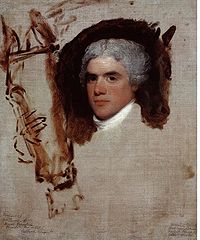Annotation:Miss C. Ramsay’s Fancy: Difference between revisions
No edit summary |
No edit summary |
||
| Line 5: | Line 5: | ||
<br> | <br> | ||
<br> | <br> | ||
[[File:ricketts.jpg|200px|thumb|left|John Bill Ricketts in an unfinished painting by American painter Gilbert Stuart, from the last years of the 18th century.]] | |||
In 1792, the the year after Watlen's publication, the Scots-born Ricketts emigrated to America, where he became a circus promoter himself and flourished through the 1790's till about 1800, when his Philadelphia enterprise was destroyed in a fire on Dec. 17, 1799. He reportedly delighted his audiences by dancing hornpipes on the backs of galloping horses (Tribe), and toward the end of his career hired another famous American hornpipe dancer, John Durang, to produce pantomimes for him. Alan Jabbour (in "American Fiddle Tunes") says that circuses under his name appeared in New York City, Philadelphia, Norfolk, Charlestown, Albany, Boston, Hartford, and Montreal. Thus we have a performing and circus connection with three of the most popular hornpipes of all time: "[[Astley's Hornpipe]]," "[[Rickett's Hornpipe]]" and "[[Durang's Hornpipe (1)]]." See [[Annotation:Rickett's Hornpipe]] for more. | In 1792, the the year after Watlen's publication, the Scots-born Ricketts emigrated to America, where he became a circus promoter himself and flourished through the 1790's till about 1800, when his Philadelphia enterprise was destroyed in a fire on Dec. 17, 1799. He reportedly delighted his audiences by dancing hornpipes on the backs of galloping horses (Tribe), and toward the end of his career hired another famous American hornpipe dancer, John Durang, to produce pantomimes for him. Alan Jabbour (in "American Fiddle Tunes") says that circuses under his name appeared in New York City, Philadelphia, Norfolk, Charlestown, Albany, Boston, Hartford, and Montreal. Thus we have a performing and circus connection with three of the most popular hornpipes of all time: "[[Astley's Hornpipe]]," "[[Rickett's Hornpipe]]" and "[[Durang's Hornpipe (1)]]." See [[Annotation:Rickett's Hornpipe]] for more. | ||
<br> | <br> | ||
Revision as of 04:03, 6 July 2013
Back to Miss C. Ramsay’s Fancy
MISS C. RAMSAY'S FANCY. Scottish, Country Dance Tune (2/4 time). E Flat Major (Watlen): D Major (Aird). Standard tuning (fiddle). AABA. The tune was first published in John Watlen's The Celebrated Circus Tunes (Edinburgh, 1791), a title that references Edinburgh's Royal Circus, an extension of Phillip Astley's Royal Circus in London. It is one of several tunes in the collection that Watlen noted was danced by "Mr. Rickets", referring to John Bill Ricketts, a dancer at Edinburgh's Royal Circus. The circus provided an alternative entertainment to concerts, opera and the theater, where equestrian acts, acrobatics, song and dance, and pantomime were performed.

In 1792, the the year after Watlen's publication, the Scots-born Ricketts emigrated to America, where he became a circus promoter himself and flourished through the 1790's till about 1800, when his Philadelphia enterprise was destroyed in a fire on Dec. 17, 1799. He reportedly delighted his audiences by dancing hornpipes on the backs of galloping horses (Tribe), and toward the end of his career hired another famous American hornpipe dancer, John Durang, to produce pantomimes for him. Alan Jabbour (in "American Fiddle Tunes") says that circuses under his name appeared in New York City, Philadelphia, Norfolk, Charlestown, Albany, Boston, Hartford, and Montreal. Thus we have a performing and circus connection with three of the most popular hornpipes of all time: "Astley's Hornpipe," "Rickett's Hornpipe" and "Durang's Hornpipe (1)." See Annotation:Rickett's Hornpipe for more.
Source for notated version:
Printed sources: Aird (Selection of Scotch, English, Irish and Foreign Airs, vol. 4), 1796; No. 95, p. 38. Watlen (The Celebrated Circus Tunes), 1791; p. 13.
Recorded sources:
